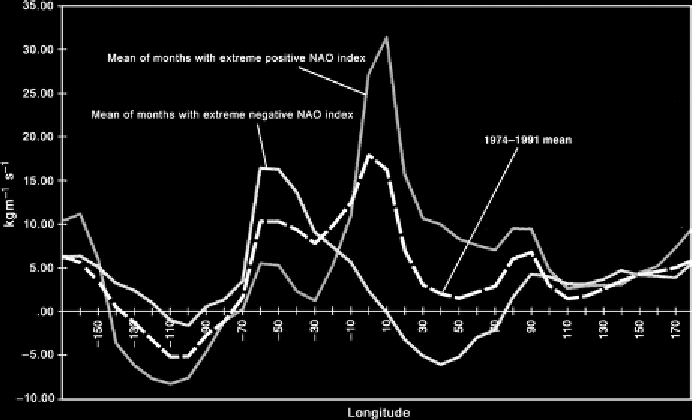Geoscience Reference
In-Depth Information
Figure 6.11.
Vertically integrated meridional moisture flux crossing 70°N in winter
expressed as a function of longitude for composites of winter (DJF) months representing
positive-index and negative-index NAO extremes. The 1974-1991 winter mean is also
shown (from Dickson et al.,
2000
, by permission of AMS).
Low and the Azores high, the two major atmospheric centers of action on in the
North Atlantic. As discussed there, and apparent in
Figure 4.19
, the phase of the
NAO, particularly in winter, is associated with anomalies in surface air temperature
encompassing large parts of the Arctic, similar in structure to those associated with
the phase of the Arctic Oscillation, or AO (
Figure 4.22
), It should come as no sur-
prise that the NAO/AO also has pronounced hydrologic impacts (in
Chapter 7
we
examine impacts on the sea ice cover).
As part of their summary of high-latitude NAO impacts, Dickson et al. (
2000
)
compared patterns of the vertically integrated moisture flux across 70°N for winters
associated with NAO extremes. The data set spanned the years 1974-1991. Their
analysis (
Figure 6.11
) shows that the poleward meridional moisture flux for lon-
gitudes along the Nordic seas is much higher under the positive NAO phase when
the Icelandic Low is strong. The positive NAO is also associated with a stronger
southerly moisture flux between about 70-140°W over Canada. In turn, there are
strong NAO precipitation signals in the Atlantic gateway to the Arctic. Dickson
et al. (
2000
) compiled composite differences of Northern Hemisphere precipitation
with respect to NAO extremes using a blended land/ocean data set for 1979-1995.
The largest precipitation increases (up to 150 mm per winter) during positive NAO
conditions are found in the Norwegian-Greenland seas and Scandinavia.
Rogers et al. (
2001
) performed a comprehensive assessment of relationships
between the NAO and AO with P-ET as averaged over the north polar cap (the
region north of 70°N). P-ET was calculated from the aerological method using
data from the NCEP/NCAR reanalysis. For winter, spring, summer, and autumn,

